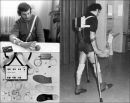|

research topics for students
research overview 1963-2011:

research then
[click on the image to enlarge]

research now
[click on the image to enlarge]
our work:
electroporation
ect
egt
wound healing
perfusion and oxygenation oxygenation
modeling of currents and fields currents and fields
development of electronic devices electronic devices
it for clinical trials
trials
|

RESEARCH WORK IN THE LABORATORY
THE BEGINNINGS
Since
its foundation in 1963 by the late
Professor Lojze Vodovnik, the Laboratory of Biocybernetics has been
involved in the study of interaction between electromagnetic fields
(EMFs) and biological systems. This includes both the
investigation of harmful effects of EMFs
on organisms and the exploitation of beneficial effects of
EMFs for therapeutic and diagnostic purposes.
The research activities of our group have been directed above all
towards the latter. During the period from the mid-1960s to the end
of the 1970s, the major research topic was Functional
Electrical Stimulation (FES).
Extensive work was done in collaboration with
Slovenian Institute of Rehabilitation
on the use of electric currents for the restoration of impaired
motor functions caused by different types of neuromuscular
diseases. Considerable success was achieved in paraplegic persons
and in hemiplegic patients recovering from brain stroke. The major
advantage of FES implemented in the so-called Ljubljana
School of Walking has been its
combination of efficacy and simplicity of application. The idea
behind this type of FES has been adopted by many rehabilitation
centers in the world. At our school it is being developed further in
the Laboratory of Robotics
at our faculty. A
FES Museum at the faculty contains 43 exhibits dating from the beginning of the 20th century
to the beginning of the 1990s. Since 2013, the most important achievements in this field are also presented in the
Virtual exhibition "Health through Technology" prepared by the Technical Museum of Slovenia in Bistra.
CURRENT RESEARCH
Since 1980s, our main field of research are the investigations of
the influence of electric currents and electromagnetic fields on the
physiological state of cells, tissues, organs, and the body as a
whole. The aims of this research are to understand the basic
mechanisms of bioelectric phenomena and to facilitate their use for
therapeutic purposes. Major directions pursued in our group are
cell membrane electroporation
with its applications in biology, biotechnology, and medicine, particularly
electrochemotherapy of tumors (ECT)
and electrogene therapy (EGT),
electrical stimulation of
chronic wound healing and
non-invasive measurements of tissue perfusion
and oxygenation.
To gain an insight into the studied phenomena, we
are determining, both analytically and numerically, the distribution of currents
and fields within
cell suspensions and tissues.
We are also developing the electronic
devices for
application in these fields of research,
as well as information technology for clinical trials. A more detailed description of our work in
each field can be obtained by following the links on the left.
We regularly present
the results of our research in articles in SCI-ranked scientific
journals (over 140 articles since 2000), as well as at scientific conferences and
meetings. For our inventions we received two European and two US patents.
We
are cooperating with several research institutions and industrial
partners from around Europe. Within the CLINIPORATOR
project of the 5th EU Framework (2000-2003), we have collaborated with
partners from France, Belgium, Denmark, Germany, Italy, and Sweden,
in developing a prototype of a clinical electroporator – a device
for ECT and EGT in patients. Within
the ESOPE project
(www.cliniporator.com) of
the 5th EU Framework (2003-2005), we have worked with four
medical and research centers from France, Denmark, Ireland, and
Slovenia, in establishing standard operating
procedures for electrochemotherapy and electrogenetherapy. Within the ANGIOSKIN
project of the 6th EU framework (since 2005) we teamed up with partners from France,
Belgium, Italy, Denmark and Germany in developing a system for skin
EGT, which is characterized by delivering the gene material and electric pulses through
hollow needle microelectrodes.
EDUCATION
Students are encouraged to participate in our research, and some
start with their work in the very first year of undergraduate
studies at our faculty. After graduation, some pursue a postgraduate
course, deepening and broadening their knowledge. Four to six
students graduate in our lab each year, and two to three
postgraduate students obtain their M.S. or Ph.D. degrees.
|
 |

